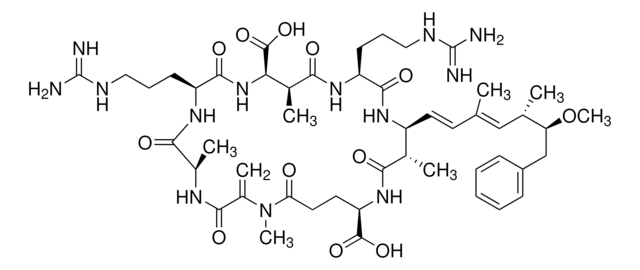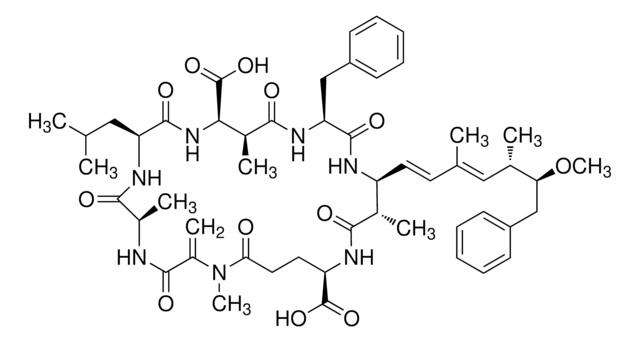33576
Microcystin-YR solution
10 μg/mL in methanol, analytical standard
Synonym(s):
Algae bloom toxin, Biotoxin, Cyanobacterial toxin
About This Item
Recommended Products
grade
analytical standard
shelf life
limited shelf life, expiry date on the label
concentration
10 μg/mL in methanol
technique(s)
HPLC: suitable
gas chromatography (GC): suitable
application(s)
environmental
format
single component solution
storage temp.
−20°C
SMILES string
CO[C@@H](Cc1ccccc1)[C@@H](C)\C=C(C)\C=C\[C@@H]2NC(=O)[C@H](CCCNC(N)=N)NC(=O)[C@@H](C)[C@@H](NC(=O)[C@H](Cc3ccc(O)cc3)NC(=O)[C@@H](C)NC(=O)C(=C)N(C)C(=O)CC[C@@H](NC(=O)[C@H]2C)C(O)=O)C(O)=O
InChI
1S/C52H72N10O13/c1-28(25-29(2)41(75-8)27-34-13-10-9-11-14-34)16-21-37-30(3)44(65)59-39(50(71)72)22-23-42(64)62(7)33(6)47(68)56-32(5)46(67)60-40(26-35-17-19-36(63)20-18-35)49(70)61-43(51(73)74)31(4)45(66)58-38(48(69)57-37)15-12-24-55-52(53)54/h9-11,13-14,16-21,25,29-32,37-41,43,63H,6,12,15,22-24,26-27H2,1-5,7-8H3,(H,56,68)(H,57,69)(H,58,66)(H,59,65)(H,60,67)(H,61,70)(H,71,72)(H,73,74)(H4,53,54,55)/b21-16+,28-25+/t29-,30-,31-,32+,37-,38-,39+,40-,41-,43+/m0/s1
InChI key
OWHASZQTEFAUJC-GJRPNUFSSA-N
General description
Application
signalword
Danger
Hazard Classifications
Acute Tox. 3 Dermal - Acute Tox. 3 Inhalation - Acute Tox. 3 Oral - Flam. Liq. 2 - STOT SE 1
target_organs
Eyes,Central nervous system
Storage Class
3 - Flammable liquids
wgk_germany
WGK 2
flash_point_f
51.8 °F
flash_point_c
11 °C
ppe
Eyeshields, Faceshields, Gloves
Choose from one of the most recent versions:
Already Own This Product?
Find documentation for the products that you have recently purchased in the Document Library.
Our team of scientists has experience in all areas of research including Life Science, Material Science, Chemical Synthesis, Chromatography, Analytical and many others.
Contact Technical Service










